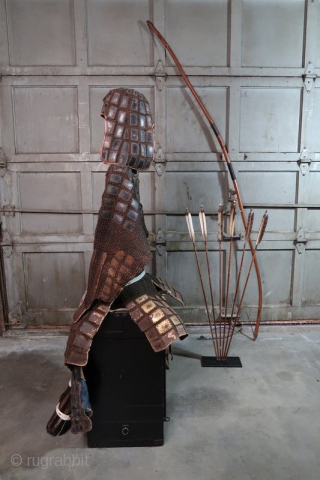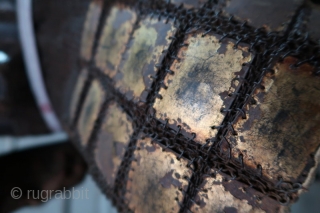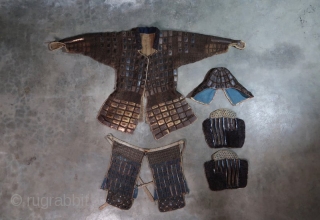Back
Antique Japanese Tatami Gurata Gusoku
The tatami armor was used by foot soldiers, archers, and spearmen. Its a lightweight armor which allowed the warriors to be more swift and fluid with their movements. It is also an economical munition armor as a alternative to the traditional lace scale construction. Going to battle was costly and this gave the clan army full protection from all levels of warfare. The armors head gear covering has two flaps with a back slit. The head gear is completely made of russet iron plates that is chain mail together. The underneath lining is of hemp indigo and is finished with a Doe leather trim. The tunic jacket is completely plated and chain mail, linked together forming a grid pattern. The arm guards have slatted iron plates and chain mail The thumb plates and hand plates is covered in russet lacquer. The iron tunic cross folded extends to the hip area, which is sectioned in four flaps with rectangular iron plates. The collar is made of dark brown woolen material and is finished edge with doe leather trim. The tatami armor is outfitted with a haidate (thigh guard) and sunete (shin guard).
Includes an original Edo Period Armor box. Set of Japanese Mounted Hawk Arrows Sold Separately. Japanese Archers Bow Sold Separately.
Edo Period 19th Century
The tatami armor was used by foot soldiers, archers, and spearmen. Its a lightweight armor which allowed the warriors to be more swift and fluid with their movements. It is also an economical munition armor as a alternative to the traditional lace scale construction. Going to battle was costly and this gave the clan army full protection from all levels of warfare. The armors head gear covering has two flaps with a back slit. The head gear is completely made of russet iron plates that is chain mail together. The underneath lining is of hemp indigo and is finished with a Doe leather trim. The tunic jacket is completely plated and chain mail, linked together forming a grid pattern. The arm guards have slatted iron plates and chain mail The thumb plates and hand plates is covered in russet lacquer. The iron tunic cross folded extends to the hip area, which is sectioned in four flaps with rectangular iron plates. The collar is made of dark brown woolen material and is finished edge with doe leather trim. The tatami armor is outfitted with a haidate (thigh guard) and sunete (shin guard).
Includes an original Edo Period Armor box. Set of Japanese Mounted Hawk Arrows Sold Separately. Japanese Archers Bow Sold Separately.
Edo Period 19th Century
price:
POR
- Home
- Antique Rugs by Region
- Category
- Profiles
- Post Items Free
- Albums
- Benaki Museum of Islamic Art
- Budapest: Ottoman Carpets
- Gulbenkian Museum
- Islamic Carpets. Brooklyn
- Islamic Textiles. Brooklyn
- Konya Museum: Rugs
- MKG, Hamburg
- MMA: Caucasian Carpets
- MMA: Mamluk Carpets
- MMA: Mughal Indian Carpets
- MMA: Ottoman Carpets
- MMA: Safavid Persian Carpets
- MMA: Turkmen Rugs
- McCoy Jones Kilims
- Ottoman textiles. Met
- Philadelphia Museum
- Rugs and Carpets: Berlin
- Seljuqs at the Met
- TIEM, Istanbul: Carpets
- V&A: Classical Carpets
- Vakiflar Carpets: Istanbul
- Baluch Rugs: Indianapolis
- Gallery Exhibitions
- Jaf an Exhibition
- Alberto Levi Gallery
- Andean Textile
- Christie's London: 2016
- Francesca Galloway
- HALI at 40
- ICOC Washington, DC 2018
- Jajims of the Shahsavan
- London Islamic Week April, 2018
- Mongolian Felts
- Navajo Rugs: JB Moore
- Persian Piled Weavings
- SF Tribal & Textile Art Show 2020
- SF Tribal 2019
- Sotheby's: C. Alexander
- Turkish Prayer Rugs
- Turkmen Main Carpets ICOC 2007












